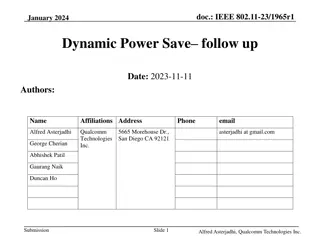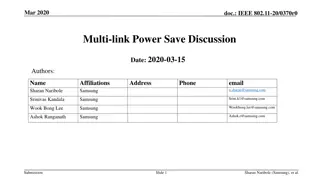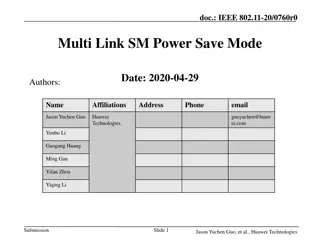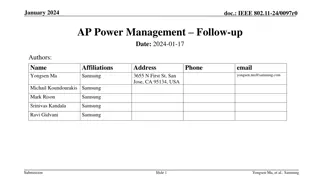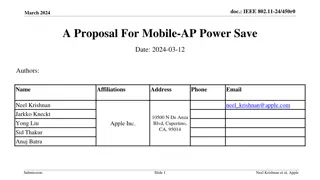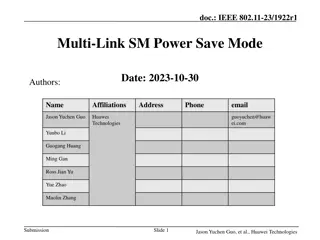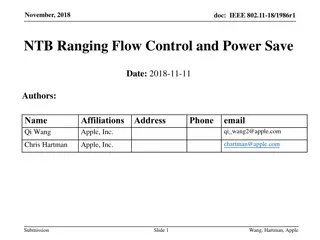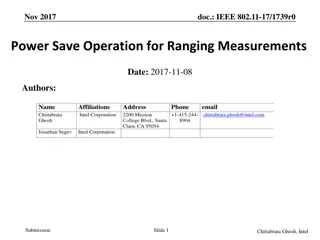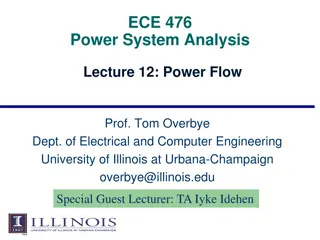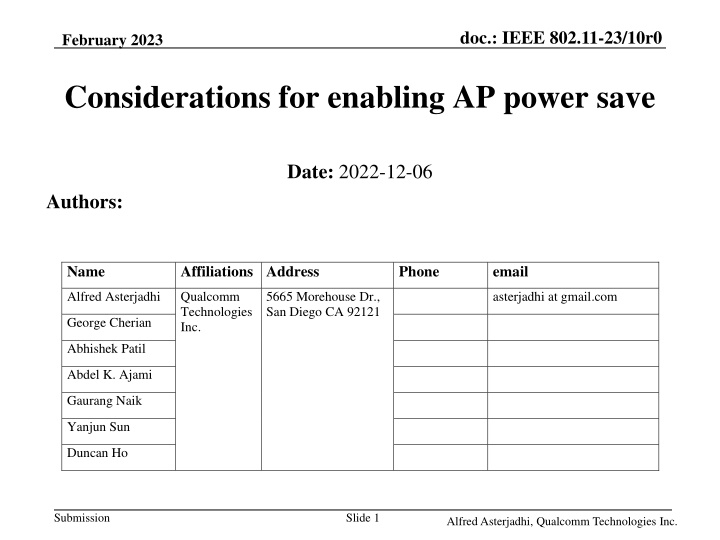
Enabling AP Power Save Considerations in IEEE 802.11 Networks
Explore considerations for enabling Access Point (AP) power save modes in IEEE 802.11 networks to reduce energy consumption, maintenance costs, and ecological footprint. Learn about existing power save modes, limitations, and strategies for efficient AP operation.
Download Presentation

Please find below an Image/Link to download the presentation.
The content on the website is provided AS IS for your information and personal use only. It may not be sold, licensed, or shared on other websites without obtaining consent from the author. If you encounter any issues during the download, it is possible that the publisher has removed the file from their server.
You are allowed to download the files provided on this website for personal or commercial use, subject to the condition that they are used lawfully. All files are the property of their respective owners.
The content on the website is provided AS IS for your information and personal use only. It may not be sold, licensed, or shared on other websites without obtaining consent from the author.
E N D
Presentation Transcript
doc.: IEEE 802.11-23/10r0 February 2023 Considerations for enabling AP power save Date: 2022-12-06 Authors: Name Affiliations Address Phone email Alfred Asterjadhi Qualcomm Technologies Inc. 5665 Morehouse Dr., San Diego CA 92121 asterjadhi at gmail.com George Cherian Abhishek Patil Abdel K. Ajami Gaurang Naik Yanjun Sun Duncan Ho Submission Slide 1 Alfred Asterjadhi, Qualcomm Technologies Inc.
doc.: IEEE 802.11-23/10r0 February 2023 Introduction Nowadays mainstream APs are expected to be always in Active mode Operate using the highest bandwidths (BW) and # of spatial streams (NSS) so that Associated STAs can get the highest throughput and fastest service possible And reducing AP power consumption has not gained sufficient traction Mainly because the APs are traditionally wall powered However, the power consumed by APs is significant (tens of watts) And this energy needs to be generated somewhere which: Increases the maintenance costs of the network, Reduces the battery life of the device (if battery operated) Increased the ecological footprint of deployed networks And is even more emphasized for multi link and multi-AP networks Since power consumption increases with the number of links/APs Submission Slide 2 Alfred Asterjadhi, Qualcomm Technologies Inc.
doc.: IEEE 802.11-23/10r0 February 2023 Summary of existing AP power save modes 1. BW/NSS reduction: Advertised by any AP via operation (mode) IEs in beacons AP can reduce the max BW/NSS that associated STAs can use when exchanging frames Similarly, the AP can modify the MCS set as well Associated STAs are required to use the most recent BW/NSS/MCS sets advertised by the AP 2. Link Disablement: AP MLD temporarily disables the link of an affiliated EHT AP STAs on the disabled link either move to another BSS or suspend operation on that link (if multi-link) Requires the AP MLD to keep at least one enabled link to serve all associated STAs 3. Scheduled AP PS modes (available and advertised by an S1G AP) AP sets the Responder PM bit to 1 if the AP intends to go to doze state outside of TWT SPs AP explicitly indicates during which beacon interval (BI) it may go to doze state outside of SPs By setting the PM bit to 1 in the Beacon frame that precedes that BI The SPs can be the negotiated TWT SPs or certain restricted access windows (RAWs) STAS are expected to not transmit outside of these SPs Submission Slide 3 Alfred Asterjadhi, Qualcomm Technologies Inc.
doc.: IEEE 802.11-23/10r0 February 2023 Limitations of existing AP PS modes 1. BW/NSS reduction (for 11n APs and beyond): Long term change that impact all associated STAs operating on that link Transition duration is in the order of several DTIM periods Reduced throughput and/or increased latency during reduced BW/NSSs period Which is also in the order of DTIM periods 2. Link Disablement (for 11be APs and beyond): Long term changes that impact all STAs operating on that link Transition duration is in the order of several DTIM periods No throughput and no service ( infinite latency ) during the disabled period Which is also in the order of DTIM periods Some consequential impact on the enabled links of that AP MLD as well E.g., increased loads on enabled links due to traffic steering from disabled links 3. Scheduled AP PS modes (for 11ah APs): Medium term changes that impact all STAs operating on that link Transition duration is in the order of beacon intervals No throughput and no service outside of the service periods Which is in the order of tens of milliseconds Submission Slide 4 Alfred Asterjadhi, Qualcomm Technologies Inc.
doc.: IEEE 802.11-23/10r0 February 2023 Candidate AP PS modes for UHR 1. Scheduled AP PS E.g., TWT-based ON-OFF duty cycling of AP s operation Medium term changes that impact all STAs operating on that link E.g., based on scheduled doze service periods within beacon intervals 2. Dynamic AP PS E.g., based on dynamic SM PS/eMLSR enablement at the AP side Short term changes that impact all STAs operating on that link E.g., initial control frame usage to enable higher BW/NSS modes Submission Slide 5 Alfred Asterjadhi, Qualcomm Technologies Inc.
doc.: IEEE 802.11-23/10r0 February 2023 Overall Summary Qualitative overview of the different AP PS modes AP PS modes Status Inactive Periods Active Periods Inactive/Active Duration PS benefits KPI1 impact BW/NSS-based Baseline None All None/All Medium Medium High2 Link Disablement Baseline In Disabled Links In Enabled Links (At least one link) ~ Seconds or more (order of DTIM interval) Higher Medium3 Medium3 Scheduled AP PS UHR Candidate Outside Wake SPs Within Wake SPs ~ Tens of ms. or more Dynamic AP PS UHR Candidate None All None/All Medium Minimal 1. 2. 3. Key performance indicator (KPI) refers to one of throughput, latency or reliability. AP power save is the highest on the disabled links, with no power save on the enabled link. There is a trade-off between AP PS and KPI impact which depends on the on-off duty cycle. An AP MLD could use a combination of different AP PS modes To minimize the overall power consumption of the system while Minimizing the impact to the KPIs of the associated STAs Next, we provide additional insights on two candidate AP PS modes First covering scheduled AP PS, Then covering dynamic AP PS Submission Slide 6 Alfred Asterjadhi, Qualcomm Technologies Inc.
doc.: IEEE 802.11-23/10r0 February 2023 Scheduled AP PS for UHR Requirements at the AP: Generate Beacons, and certain MGMT frames in non-HT PPDUs (baseline) Generate DL PPDUs (subject to assoc. STAs caps., and op. modes (baseline)) RX of UL PPDUs is subject to the AP being in Awake state (new requirement) I.e., new rules are needed to avoid STAs sending frames to an AP that is in Doze state Mode enabled by AP only if all associated STAs support the AP entering this mode Target: Enable AP to save power outside of awake SPs The longer inter-SP separation the lower the power consumption Simplicity and predictability from a protocol perspective STAs either negotiate or know in advance the periods during which the AP is expected to be in doze state Use existing mechanisms (e.g., use TWT-based AP PS & set dot11APPowerSaveImplemented to true) Submission Slide 7 Alfred Asterjadhi, Qualcomm Technologies Inc.
doc.: IEEE 802.11-23/10r0 February 2023 Scheduled AP PS for UHR (cont.) Issues that need careful consideration: Opportunities for AP to save power are highly dependent on the STAs associated to it (whether they support it) Active scanning is not possible during periods when AP is in doze state Sleep patterns of the AP need to consider the QoS parameters of the associated STAs Trade-off between STAs traffic requirement and AP s power consumption Could be addressable by using scheduled AP PS with MLO Require one link to be always enabled (in AM mode) while the other links use scheduled AP PS Legacy STAs and STAs that don t support scheduled AP PS operate on the AM link (which provides active discovery as well) Submission Slide 8 Alfred Asterjadhi, Qualcomm Technologies Inc.
doc.: IEEE 802.11-23/10r0 February 2023 Dynamic AP PS for UHR Requirements at the AP: DL and beacon generation are the same as baseline (see previous slide) RX UL PPDUs subject to initiating frames that precedes them satisfying strict requirements These initiating frames will cause the AP to transition from Listen State to Awake State Need to define rules to enable this (dynamic SMPS/eMLSR-like) functionality at AP side E.g., by requiring initiating frames (e.g.. RTS frame) be carried in non-HT (dup) PPDU format, etc. Mode enabled by AP only if all associated STAs support the AP entering this mode Target: AP to save power (e.g., stay in Listen State) most of the time, unless solicited to Awake Listen State: AP is capable of RX PPDUs of a certain configuration (e.g., non-HT (dup) PPDUs, etc.) Awake State: AP is awake & capable of RX PPDUs with highest BW/NSS (e.g., advertised in Beacons) Simplicity and predictability from a protocol perspective Require that every exchange is initiated with a frame exchange that causes transition from listen to awake E.g., define dynamic SMPS/eMLSR-like protocols at the AP side Issue that needs careful consideration (see next slide) Use of dynamic AP PS is highly dependent on what STAs are associated to it Submission Slide 9 Alfred Asterjadhi, Qualcomm Technologies Inc.
doc.: IEEE 802.11-23/10r0 February 2023 Dynamic AP PS for UHR (cont.) An AP in dynamic AP PS is expected to natively support active & passive scanning Pre-association UL frames are expected to be exchanged in non-HT PPDU format And AP can decide what format to use for DL frames, but generally Uses non-HT PPDU format for Beacons, Probe Responses, and so on To avoid missing UL frames being sent by associated STAs, either of these rules need to apply: An AP may go to Listen State only when all associated STAs are (capable of) initiating their exchanges with non-HT (dup) PPDU E.g., the AP must disable dynamic AP PS if there is at least one associated STA that does not support it An AP MLD must keep at least one link where dynamic AP PS mode is disabled If there is at least one STA that does not support dynamic AP PS, then they must operate on that link Submission Slide 10 Alfred Asterjadhi, Qualcomm Technologies Inc.
doc.: IEEE 802.11-23/10r0 February 2023 Conclusions We have discussed candidate power save protocols for the AP aiming at Minimizing power consumption while ensuring that STAs continue to be serviced without disruptions Accounting for the necessary trade-offs/constraints Which arise due to use cases/scenarios and/or device configurations We covered both Scheduled AP PS: medium term PS mode that enables deep sleep in the form of Doze state (DS): AP enters doze state (i.e., powered off) and is Capable of storing association states but has no RX/TX functionalities Dynamic AP PS: short term PS mode that enables light sleep in the form of Listen state (LS): AP has limited operation (e.g., RX/TX@High BW/NSS are off) and is Capable of maintaining minimal RX functionality (e.g., RX non-HT PPDU only) Submission Slide 11 Alfred Asterjadhi, Qualcomm Technologies Inc.




